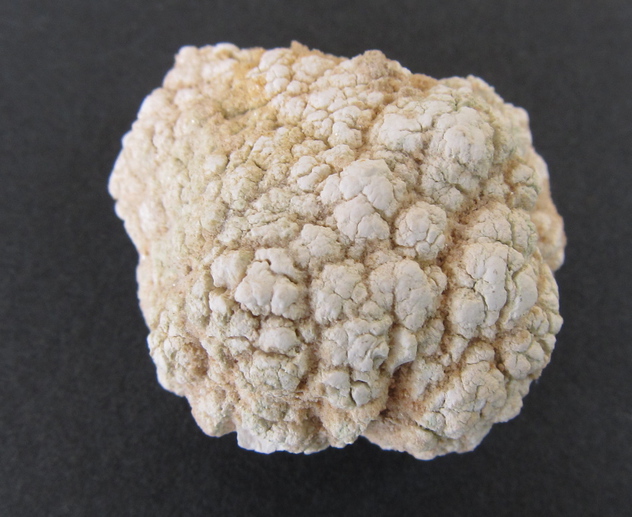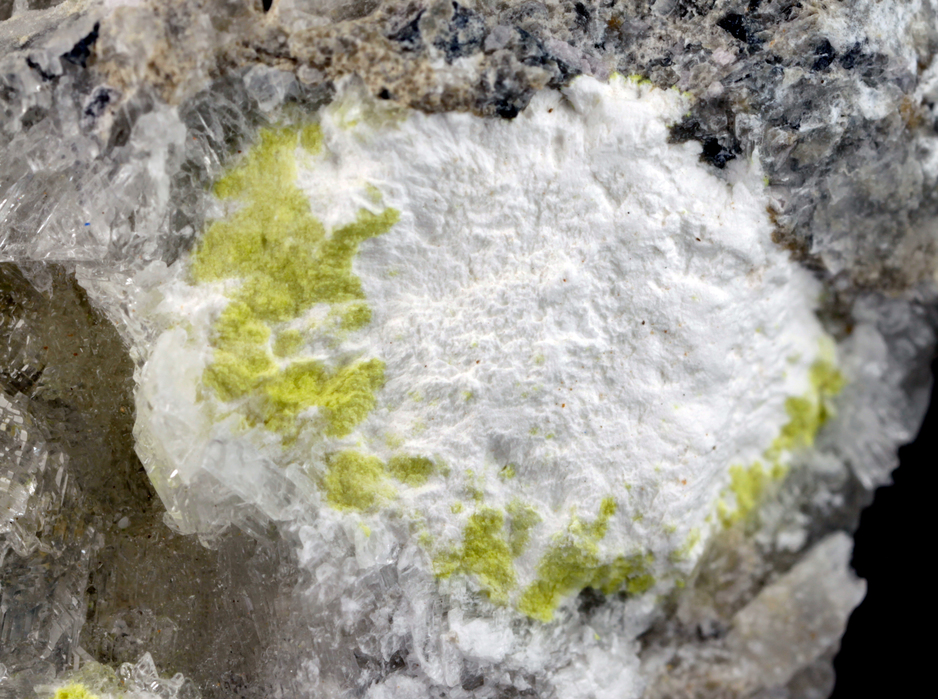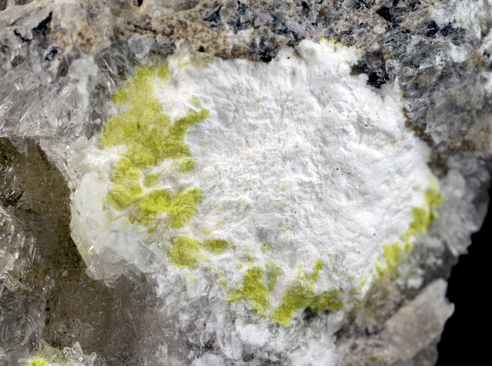Kingite
A valid IMA mineral species - grandfathered
This page is currently not sponsored. Click here to sponsor this page.
About Kingite
Formula:
Al3(PO4)2F2(OH) · 7H2O
Originally assumed to be Al3(PO4)2(OH)3.9H2O.
Colour:
White, colorless, greenish yellow
Lustre:
Vitreous, Dull
Specific Gravity:
2.21 - 2.30
Crystal System:
Triclinic
Name:
Named in 1957 by Keith Norrish, Lillian E.R. Rogers, and R.E. Shapter in honor of Donald King (3 June 1926, Adelaide, Australia - 3 August 1989, The Gap, Australia), exploration geologist and mining executive with a varied background. He made significant contributions to the coal industry in Queensland. He collected the first specimens of kingite while he was a geologist with the Department of Mines, Adelaide, South Australia.
This page provides mineralogical data about Kingite.
Unique Identifiers
Mindat ID:
2210
Long-form identifier:
mindat:1:1:2210:7
GUID
(UUID V4):
(UUID V4):
e330a1ba-46e8-43a9-b28f-e6a8d2df9873
IMA Classification of Kingite
Approved, 'Grandfathered' (first described prior to 1959)
First published:
1957
Classification of Kingite
8.DC.47
8 : PHOSPHATES, ARSENATES, VANADATES
D : Phosphates, etc. with additional anions, with H2O
C : With only medium-sized cations, (OH, etc.):RO4 = 1:1 and < 2:1
8 : PHOSPHATES, ARSENATES, VANADATES
D : Phosphates, etc. with additional anions, with H2O
C : With only medium-sized cations, (OH, etc.):RO4 = 1:1 and < 2:1
42.10.3.1
42 : HYDRATED PHOSPHATES, ETC.CONTAINING HYDROXYL OR HALOGEN
10 : A3(XO4)2Zq·xH2O
42 : HYDRATED PHOSPHATES, ETC.CONTAINING HYDROXYL OR HALOGEN
10 : A3(XO4)2Zq·xH2O
19.7.11
19 : Phosphates
7 : Phosphates of Al alone
19 : Phosphates
7 : Phosphates of Al alone
Mineral Symbols
As of 2021 there are now IMA–CNMNC approved mineral symbols (abbreviations) for each mineral species, useful for tables and diagrams.
| Symbol | Source | Reference |
|---|---|---|
| Kgi | IMA–CNMNC | Warr, L.N. (2021). IMA–CNMNC approved mineral symbols. Mineralogical Magazine, 85(3), 291-320. doi:10.1180/mgm.2021.43 |
Physical Properties of Kingite
Vitreous, Dull
Transparency:
Translucent
Colour:
White, colorless, greenish yellow
Streak:
White
Density:
2.21 - 2.30 g/cm3 (Measured) 2.465 g/cm3 (Calculated)
Optical Data of Kingite
Type:
Biaxial
Dispersion:
strong
Chemistry of Kingite
Mindat Formula:
Al3(PO4)2F2(OH) · 7H2O
Originally assumed to be Al3(PO4)2(OH)3.9H2O.
Originally assumed to be Al3(PO4)2(OH)3.9H2O.
Crystallography of Kingite
Crystal System:
Triclinic
Cell Parameters:
a = 9.15(1) Å, b = 10.00(1) Å, c = 7.24(2) Å
α = 98.6(1)°, β = 93.6(1)°, γ = 93.2(1)°
α = 98.6(1)°, β = 93.6(1)°, γ = 93.2(1)°
Ratio:
a:b:c = 0.915 : 1 : 0.724
Unit Cell V:
652.29 ų (Calculated from Unit Cell)
Z:
2
Morphology:
Platelets or irregular fragments, to 1 µm, aggregated in nodules; as crusts of intergrown spheroids resembling fish roe.
Comment:
Point Group: 1 or 1; Space Group: P1 or P1.
Crystal Structure
Load
Unit Cell | Unit Cell Packed
2x2x2 | 3x3x3 | 4x4x4
Unit Cell | Unit Cell Packed
2x2x2 | 3x3x3 | 4x4x4
Show
Big Balls | Small Balls | Just Balls | Spacefill
Polyhedra Off | Si Polyhedra | All Polyhedra
Remove metal-metal sticks
Big Balls | Small Balls | Just Balls | Spacefill
Polyhedra Off | Si Polyhedra | All Polyhedra
Remove metal-metal sticks
Display Options
Black Background | White Background
Perspective On | Perspective Off
2D | Stereo | Red-Blue | Red-Cyan
Black Background | White Background
Perspective On | Perspective Off
2D | Stereo | Red-Blue | Red-Cyan
View
CIF File Best | x | y | z | a | b | c
CIF File Best | x | y | z | a | b | c
Rotation
Stop | Start
Stop | Start
Labels
Console Off | On | Grey | Yellow
Console Off | On | Grey | Yellow
Data courtesy of the American Mineralogist Crystal Structure Database. Click on an AMCSD ID to view structure
| ID | Species | Reference | Link | Year | Locality | Pressure (GPa) | Temp (K) |
|---|---|---|---|---|---|---|---|
| 0002976 | Kingite | Wallwork K S, Pring A, Taylor M R, Hunter B A (2003) A model for the structure of the hydrated aluminum phosphate, kingite determined by ab initio powder diffraction methods American Mineralogist 88 235-239 |  | 2003 | 0 | 293 | |
| 0005931 | Kingite | Wallwork K S, Pring A, Taylor M R, Hunter B A (2004) The network of hydrogen bonding in kingite, as revealed by a neutron-diffraction investigation of its deuterated analogue, Al3(PO4)2F3.7D2O The Canadian Mineralogist 42 135-141 |  | 2004 | 0 | 293 |
CIF Raw Data - click here to close
X-Ray Powder Diffraction
Powder Diffraction Data:
| d-spacing | Intensity |
|---|---|
| 9.1 Å | (100) |
| 3.45 Å | (80) |
| 3.48 Å | (65) |
| 5.28 Å | (52) |
| 3.17 Å | (39) |
| 3.108 Å | (30) |
| 5.34 Å | (28) |
Comments:
Fairview Quarry, South Australia, Australia. Data from the type description.
Geological Environment
Paragenetic Mode(s):
| Paragenetic Mode | Earliest Age (Ga) |
|---|---|
| Stage 7: Great Oxidation Event | <2.4 |
| 47a : [Near-surface hydration of prior minerals] | |
| 47c : [Carbonates, phosphates, borates, nitrates] | |
| 47g : [Halogen-bearing surface weathering minerals] |
Type Occurrence of Kingite
General Appearance of Type Material:
White nodules to 5 cm in diameter.
Place of Conservation of Type Material:
Natural History Museum, Paris, France, 175.300.
Harvard University, Cambridge, Massachusetts, USA, 109441.
National Museum of Natural History, Washington, D.C., USA, 112693.
Harvard University, Cambridge, Massachusetts, USA, 109441.
National Museum of Natural History, Washington, D.C., USA, 112693.
Geological Setting of Type Material:
Found in Cambrian and Upper Precambrian limestones. Probably of supergene origin. Thought to have been deposited by meteoric waters in fault zones and breccias during Tertiary times.
Associated Minerals at Type Locality:
Reference:
Norrish, K., Rogers, L.E.R., and Shapter, R.E. (1957) Kingite, a new hydrated aluminum phosphate mineral from Robertstown, South Australia. Mineralogical Magazine, vol. 31, n° 236, 351-357.
Other Language Names for Kingite
Common Associates
Associated Minerals Based on Photo Data:
| 4 photos of Kingite associated with Tyuyamunite | Ca(UO2)2(VO4)2 · 5-8H2O |
| 3 photos of Kingite associated with Gypsum | CaSO4 · 2H2O |
| 1 photo of Kingite associated with Volborthite | Cu3(V2O7)(OH)2 · 2H2O |
| 1 photo of Kingite associated with Fluellite | Al2(PO4)F2(OH) · 7H2O |
Related Minerals - Strunz-mindat Grouping
| 8.DC. | Ianbruceite | Zn2(AsO4)(OH) · 3H2O |
| 8.DC. | Césarferreiraite | Fe2+ Fe3+2(AsO4)2(OH)2 · 8H2O |
| 8.DC. | Ferrivauxite | Fe3+Al2(PO4)2(OH)3 · 5H2O |
| 8.DC.05 | Nissonite | Cu2Mg2(PO4)2(OH)2 · 5H2O |
| 8.DC.07 | Euchroite | Cu2(AsO4)(OH) · 3H2O |
| 8.DC.10 | Legrandite | Zn2(AsO4)(OH) · H2O |
| 8.DC.12 | Strashimirite | Cu8(AsO4)4(OH)4 · 5H2O |
| 8.DC.15 | Arthurite | CuFe3+2(AsO4)2(OH)2 · 4H2O |
| 8.DC.15 | Earlshannonite | Mn2+Fe3+2(PO4)2(OH)2 · 4H2O |
| 8.DC.15 | Ojuelaite | ZnFe3+2(AsO4)2(OH)2 · 4H2O |
| 8.DC.15 | Whitmoreite | Fe2+Fe3+2(PO4)2(OH)2 · 4H2O |
| 8.DC.15 | Cobaltarthurite | (Co,Mg)Fe3+2(AsO4)2(OH)2 · 4H2O |
| 8.DC.15 | Bendadaite | Fe2+Fe3+2(AsO4)2(OH)2 · 4H2O |
| 8.DC.15 | Kunatite | CuFe3+2(PO4)2(OH)2 · 4H2O |
| 8.DC.15 | UM2006-27-PO:FeHZn | ZnFe3+2(PO4)2(OH)2 · 4H2O |
| 8.DC.15 | UKI-2006-(PO:AlCuFeH) | Fe2+Al3+2(PO4)2(OH)2 · 4H2O |
| 8.DC.17 | Kleemanite | ZnAl2(PO4)2(OH)2 · 3H2O |
| 8.DC.20 | Bermanite | Mn2+Mn3+2(PO4)2(OH)2 · 4H2O |
| 8.DC.20 | Coralloite | Mn2+Mn3+2(AsO4)2(OH)2 · 4H2O |
| 8.DC.20 | Magnesiobermanite | MgMn3+2(PO4)2(OH)2 · 4H2O |
| 8.DC.22 | Kovdorskite | Mg2(PO4)(OH) · 3H2O |
| 8.DC.25 | Ferristrunzite | Fe3+Fe3+2(PO4)2(OH)3 · 5H2O |
| 8.DC.25 | Ferrostrunzite | Fe2+Fe3+2(PO4)2(OH)2 · 6H2O |
| 8.DC.25 | Metavauxite | Fe2+Al2(PO4)2(OH)2 · 8H2O |
| 8.DC.25 | Metavivianite | Fe2+Fe3+2(PO4)2(OH)2 · 6H2O |
| 8.DC.25 | Strunzite | Mn2+Fe3+2(PO4)2(OH)2 · 6H2O |
| 8.DC.25 | Zincostrunzite | ZnFe3+2(PO4)2(OH)2 · 6.5H2O |
| 8.DC.27 | Beraunite | Fe3+6(PO4)4O(OH)4 · 6H2O |
| 8.DC.27 | Tvrdýite | Fe2+Fe3+2 Al3(PO4)4(OH)5(H2O)4 · 2H2O |
| 8.DC.27 | Zincoberaunite | ZnFe3+5(PO4)4(OH)5 · 6H2O |
| 8.DC.30 | Gordonite | MgAl2(PO4)2(OH)2 · 8H2O |
| 8.DC.30 | Laueite | Mn2+Fe3+2(PO4)2(OH)2 · 8H2O |
| 8.DC.30 | Mangangordonite | Mn2+Al2(PO4)2(OH)2 · 8H2O |
| 8.DC.30 | Paravauxite | Fe2+Al2(PO4)2(OH)2 · 8H2O |
| 8.DC.30 | Pseudolaueite | Mn2+Fe3+2(PO4)2(OH)2 · 8H2O |
| 8.DC.30 | Sigloite | Fe3+Al2(PO4)2(OH)3 · 7H2O |
| 8.DC.30 | Stewartite | Mn2+Fe3+2(PO4)2(OH)2 · 8H2O |
| 8.DC.30 | Ushkovite | MgFe3+2(PO4)2(OH)2 · 8H2O |
| 8.DC.30 | Ferrolaueite | Fe2+Fe3+2(PO4)2(OH)2 · 8H2O |
| 8.DC.30 | Kastningite | (Mn2+,Fe2+,Mg)Al2(PO4)2(OH)2 · 8H2O |
| 8.DC.30 | Maghrebite | MgAl2(AsO4)2(OH)2 · 8H2O |
| 8.DC.30 | Nordgauite | MnAl2(PO4)2(F,OH)2 · 5H2O |
| 8.DC.30 | Kayrobertsonite | [MnAl2(PO4)2(OH)2(H2O)4] · 2H2O |
| 8.DC.30 | Kummerite | Mn2+Fe3+Al(PO4)2(OH)2 · 8H2O |
| 8.DC.32 | Tinticite | Fe3+3(PO4)2(OH)3 · 3H2O |
| 8.DC.32 | Kamarizaite | Fe3+3(AsO4)2(OH)3 · 3H2O |
| 8.DC.35 | Vauxite | Fe2+Al2(PO4)2(OH)2 · 6H2O |
| 8.DC.37 | Vantasselite | Al4(PO4)3(OH)3 · 9H2O |
| 8.DC.40 | Cacoxenite | Fe3+24AlO6(PO4)17(OH)12 · 75H2O |
| 8.DC.45 | Gormanite | (Fe2+,Mg)3(Al,Fe3+)4(PO4)4(OH)6 · 2H2O |
| 8.DC.45 | Souzalite | (Mg,Fe2+)3(Al,Fe3+)4(PO4)4(OH)6 · 2H2O |
| 8.DC.50 | Wavellite | Al3(PO4)2(OH,F)3 · 5H2O |
| 8.DC.50 | Allanpringite | Fe3+3(PO4)2(OH)3 · 5H2O |
| 8.DC.50 | Fluorwavellite | Al3(PO4)2(OH)2F · 5H2O |
| 8.DC.52 | Kribergite | Al5(PO4)3(SO4)(OH)4 · 4H2O |
| 8.DC.55 | Mapimite | Zn2Fe3+3(AsO4)3(OH)4 · 10H2O |
| 8.DC.57 | Ogdensburgite | Ca2Fe3+4(Zn,Mn2+)(AsO4)4(OH)6 · 6H2O |
| 8.DC.60 | Nevadaite | (Cu2+,Al,V3+)6Al8(PO4)8F8(OH)2 · 22H2O |
| 8.DC.60 | Cloncurryite | Cu0.5(VO)0.5Al2(PO4)2F2 · 5H2O |
| 8.DC.62 | Kenngottite | Mn2+3Fe3+4(PO4)4(OH)6(H2O)2 |
| 8.DC.67 | Molinelloite | Cu(H2O)(OH)V4+O(V5+O4) |
| 8.DC.70 | Whitecapsite | H16Fe2+5Fe3+14Sb3+6(AsO4)18O16 · 120H2O |
| 8.DC.75 | Heimite | PbCu2(AsO4)(OH)3 · 2H2O |
Other Information
Health Risks:
No information on health risks for this material has been entered into the database. You should always treat mineral specimens with care.
Internet Links for Kingite
mindat.org URL:
https://www.mindat.org/min-2210.html
Please feel free to link to this page.
Please feel free to link to this page.
Search Engines:
External Links:
Mineral Dealers:
References for Kingite
Reference List:
Norrish, K., Rogers, Lillian E. R., Shapter, R. E. (1957) Kingite, a new hydrated aluminium phosphate mineral from Robertstown, South Australia. Mineralogical Magazine and Journal of the Mineralogical Society, 31 (236) 351-357 doi:10.1180/minmag.1957.031.236.01
Norrish, K., Rogers, Lillian E. R., Shapter, R. E. (1957) Kingite, a new hydrated aluminium phosphate mineral from Robertstown, South Australia. Mineralogical Magazine and Journal of the Mineralogical Society, 31 (236) 351-357 doi:10.1180/minmag.1957.031.236.01
Localities for Kingite
Locality List
 - This locality has map coordinates listed.
- This locality has map coordinates listed.
 - This locality has estimated coordinates.
ⓘ - Click for references and further information on this occurrence.
? - Indicates mineral may be doubtful at this locality.
- This locality has estimated coordinates.
ⓘ - Click for references and further information on this occurrence.
? - Indicates mineral may be doubtful at this locality.
 - Good crystals or important locality for species.
- Good crystals or important locality for species.
 - World class for species or very significant.
(TL) - Type Locality for a valid mineral species.
(FRL) - First Recorded Locality for everything else (eg varieties).
- World class for species or very significant.
(TL) - Type Locality for a valid mineral species.
(FRL) - First Recorded Locality for everything else (eg varieties).
All localities listed without proper references should be considered as questionable.
Quick NavTopAbout KingiteUnique IdentifiersIMA Classification Classification Mineral SymbolsPhysical Properties Optical Data Chemistry Crystallography Crystal StructureX-Ray Powder DiffractionGeological EnvironmentType Occurrence Other LanguagesCommon AssociatesStrunz-MindatOther InformationInternet Links References Localities Locality List





 symbol to view information about a locality.
The
symbol to view information about a locality.
The 



Tom's Quarry, Kapunda, North Mt Lofty Ranges, Mt Lofty Ranges, South Australia, Australia